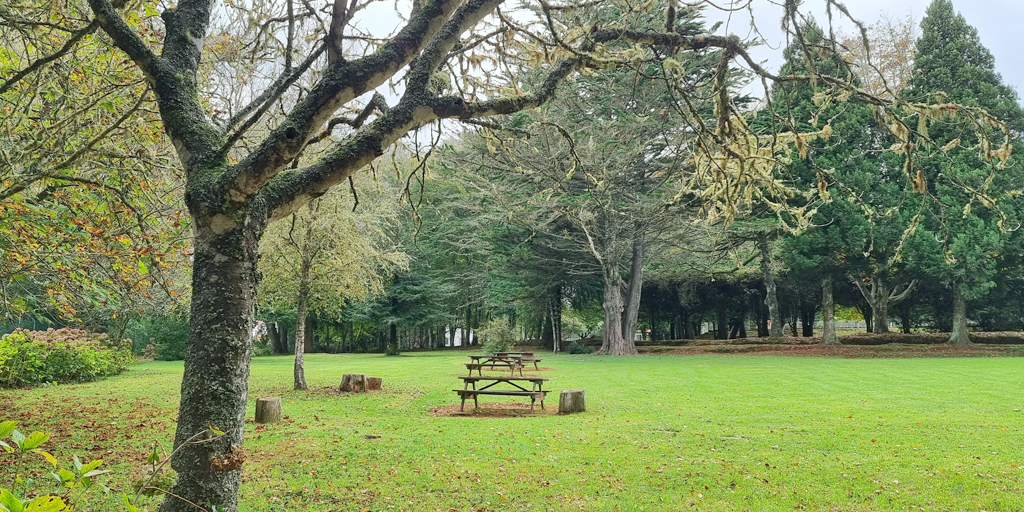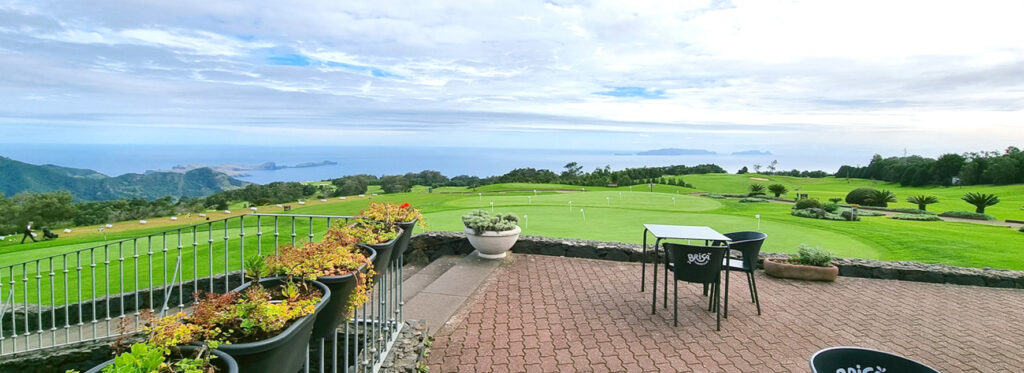
Santo António da Serra – England on Madeira
Santo António da Serra is located on a plateau at an altitude of 700 meters in the east of Madeira and is characterized by lush vegetation and a temperate climate.
The altitude ensures pleasantly cool temperatures, which is particularly appreciated in the summer months. For this reason, many English people have built their country houses there.
English Lifestyle
The Quinta do Santo da Serra (Quinta da Junta), now a large park in the center of the village, is particularly well known. This historic estate was built at the end of the 19th century by the Blandy family in the English colonial style.
A lush landscaped park with trees, some of which are of great botanical interest and come from different continents, has been created around the manor house.
In one corner of the park there is a viewpoint with a panoramic view over the Ribeira de Machico valley, Ponta de São Lourenço and even Porto Santo on a clear day. There are wooden tables and benches in an open hut right next to this Miradouro dos Ingleses; locals often meet here for a hearty picnic.
Visitors to the park can observe peacocks, fallow deer and horses in the animal enclosures.
The Santo da Serra Golf Club is also firmly in English hands. The renowned golf course was designed by architect Robert Trent Jones Senior and offers 27 holes on an extensive area. It is the venue for the Madeira Island Open and attracts golfers from all over the world who enjoy the impressive 240° panorama of the Atlantic.
The golf club’s restaurant is open to everyone and teatime on the terrace is an absolute must-do.

Local Markets and Culture
There are large areas of fruit and vegetable cultivation in the municipality and the local farmers supply many local restaurants with their products. Santo da Serra is known for its apples, from which the famous cider is made.
The traditional Sunday market, where local produce such as fruit, vegetables, flowers and handicrafts are on sale, offers a colorful insight into rural life and Madeira’s culture. Here you can stock up on fresh food and also try the regional cider, which is absolutely comparable to Hessian “Äppelwoi”.

History and Development
The name of the municipality goes back to the patron saint, who is dedicated to Santo António da Serra. However, it is usually called “Santo da Serra”.
The settlement of the parish began in the first quarter of the 16th century, but from the 17th century onwards there were territorial disputes between the parishes of Machico, Santa Cruz and Água de Pena. In 1852, some places in the parishes of Machico and Santo da Serra were incorporated into the parish of Santa Cruz by royal charter, which provoked considerable protests. As a result of a long dispute over the delimitation of their territory between the municipalities of Machico and Santa Cruz, Santo da Serra is the only municipality in Portugal to be divided between two municipalities.
In the 19th century, the Scottish doctor Robert Kalley stirred up the Catholic faithful of Santo da Serra: Kalley settled in this parish and offered free medical care in his practice. While curing physical ailments, he tried to spread Protestant ideas among his patients and the rest of the population.
The distinctly Catholic character of the island’s population naturally did not facilitate the spread of Calvinist ideas and culminated in some unrest in the municipalities of Machico and Santa Cruz. As a result of these riots, proceedings were initiated against the advocates of the new doctrine, which led to some members being imprisoned and Dr. Kalley leaving Madeira Island.
Architecture
In addition to the numerous English manor houses, there are still valuable examples of local architecture. These are one or two-storey houses with roof finials featuring boys‘ heads, dogs‘ heads, doves or other motifs with all their magical symbolism, bringing fertility to the house or warding off evil spirits. Door inserts made of colored glass are also very common.
Many streets in the municipality are lined with hydrangeas and agapantos, also known as the “African love flower”.
The Fountain of Santo António da Serra
The Fonte de Santo António da Serra, also known as Fonte do Bispo or Fonte dos Ingleses, is a historic fountain in the parish of Santo António da Serra. It probably dates back to the late 17th or early 18th century, although there are no precise records of the year of construction.
The different names of the fountain have historical backgrounds:
– Fonte do Bispo: This name is derived from the summer residence of the Bishop of Funchal, which was located near the fountain.
– Fonte dos Ingleses: During the British occupation of Madeira between 1807 and 1814, English soldiers and residents used the fountain.
Inside this fountain there are some inscriptions with the names of Englishmen who lived on farms in Santo da Serra and of English soldiers.
The Santo António da Serra fountain is made of stone with a wide arched opening and a semi-circular vaulted interior, the style of “late Mannerism”. This makes it not only an important architectural monument, but also a testimony to the cultural and historical development of the region.
The fountain is located at the fork in the road to Portela and the road leading up to the center of the municipality.
Levada da Serra do Faial
In 1830, on the initiative of the Nova Levada do Furado Society, the construction of a levada began with the aim of transporting water from Faial on the north coast to Funchal.
However, due to technical and economic difficulties, the project was abandoned by the private sector and the state was responsible for the work.
This levada then became known as Levada da Serra or, more precisely, Levada da Serra do Faial.
There are several walking routes here, one of which starts in Santo António da Serra and covers a distance of around 9 kilometers, with the average time to complete this levada being 2–3 hours.
The levada alternates between rural environments and the UNESCO-protected laurel forest.
Leisure Activities and Nature Experiences
– Hiking: The area offers numerous hiking trails, including the route from Santo da Serra to Ribeiro Frio, which runs through lush forests and along levadas.
– Horse riding: The “Equine Village by Quinta do Riacho” offers horse riding excursions through the picturesque landscape of Santo da Serra.
Looking for more stress-free adventures on Madeira?
“Madeira by Bus” is your ultimate travel companion, featuring detailed bus schedules, insider tips, and must-visit destinations across the island. Whether you’re a first-time visitor or a seasoned explorer, this guide makes it easy to plan your journey.
👉 Get your copy today at www.madeira-by-bus.com/read and start exploring Madeira the eco-friendly way!


